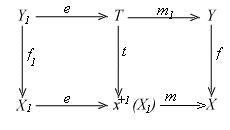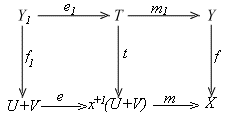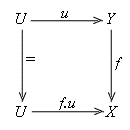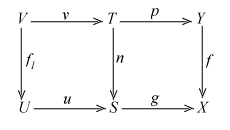For any object X denote by R(X) the set of strong
subobjects of X. Since A has finite
limits, the poset R(X) has meets. Suppose u: U
--> X and v: V --> X are two strong subobjects. Suppose
T = U + V is the sum of U and V and t: T
--> X is the map induced by u and v. Then the strong
image t(T) of T in X is the join U ![]() V of U and V in R(X). It follows
that R(X) has joins. Thus R(X) is a lattice,
with 0X: 0 --> X as zero and 1X:
X --> X as one. An object Z has exactly one strong subobject
(i.e. 0Z = 1Z) iff it is initial.
V of U and V in R(X). It follows
that R(X) has joins. Thus R(X) is a lattice,
with 0X: 0 --> X as zero and 1X:
X --> X as one. An object Z has exactly one strong subobject
(i.e. 0Z = 1Z) iff it is initial.
If u: U --> X is a mono, we denote by f-1(u) the pullback of u along f. Then f-1: R(X) --> R(Y) is a mapping preserves meets such that f-1(0X) = 0Y and f-1(1X) = 1Y (i.e. f-1 is bounded ). Also f-1 has a left adjoint f+1: R(Y) --> R(X) sending each strong subobject v: V --> Y to the strong image of the composite f.v: V --> X . If V = Y then f+1(Y) is simply the strong image of f.
Proposition 1.5.1. Suppose x: X1 --> X and f: Y --> X are two maps and f is coflat. Let y: Y1 --> Y be the pullback of x along f. Then f-1(x+1(X1)) = y+1(Y1).
Proof. Let e: X1 --> x+1(X1) and m: x+1(X1) --> X be the epi-strong-mono factorization of x. Form the pullback

Corollary 1.5.2. If x: X1 --> X is a map which is disjoint with a coflat map f: Y --> X , then the strong image of x is disjoint with f.
Proof. We shall use the notation and diagram in the proof of
(1.5.1). Since x and f are disjoint,
the pullback Y1 of x and f is 0
. The map e1: 0 = Y1 --> T is an isomorphism
as it is an epic strong mono. It follows that f and m are
disjoint.
Proposition 1.5.3. If f:
Y --> X is a coflat map, then
f-1: R(X) --> R(Y) is a morphism
of bounded lattice.
Proof. Since f-1 is bounded and preserves meets, we only need to verify that it also preserves joins. Suppose u: U --> X and v: V --> X are two strong subobjects. Let x: U + V --> X be the map induced by u and v. Then x+1(U + V) is the join of U and V . Since sums are stable, the pullback Y1 of U + V along f in the following pullback diagram is f-1(U) + f-1(V).

Proposition 1.5.4. If f: Y --> X is a coflat mono, then f-1f+1 is the identity R(Y) --> R(Y).
Proof. Suppose u: U --> Y is a strong mono. Consider the mono fu: U --> X , whose pullback along f is u .

Proposition 1.5.4 is a special case of the following Beck-Chevalley condition for strong subobjects along coflat maps:
Proposition 1.5.5. Suppose f: Y --> X is a coflat map and g: S --> X is a map. Let (p: T --> Y, n: T --> S) be the pullback of (f, g). Then p+1n-1 = f-1g+1.
Proof. Form the pullback for a strong mono u: U --> S
